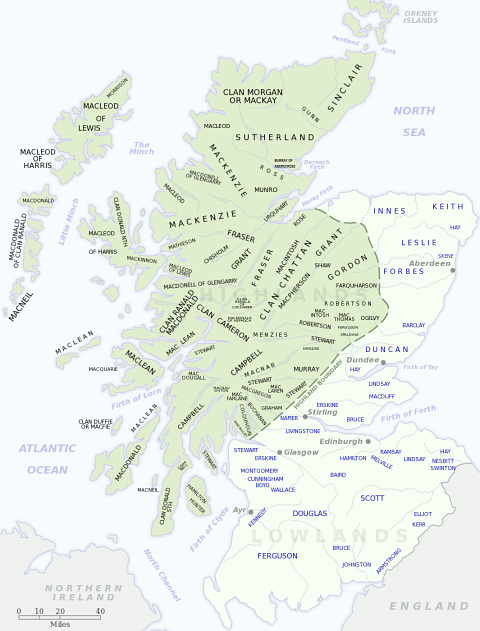
Motto: Audentes fortuna juvat (Fortune favours the bold)
Historic Seat: Castle Moil
District: Isle of Skye
Associated Surnames: MacKinney, MacKinning, MacKinven, MacMorran, Morren, Sherry
Associated Tartans:
Early MacKinnon Genealogy and History:
(Excerpt from "The Scottish Clans and Their Tartans", James Grant, 1906)
The possessions of this clan in Skye are thus described by Monro, Dean of the Isles (1594): "The Castill of Dunakym; the Castill of Dunningill pertaining to the said M'Kynnoun. At the shore of Sky lyes one iyle called Pabay, full of woods, good for fishing, and a main shelter for thieves and cut-throats. It pertains to M'Kynnonn." This ancient tribe can be traced to Ferchar Oig, and includes Finlay, the son of Fingon, from whom sprang the Clan Fingon. Their name occurs in many a feud and strife during the fourteenth and fifteenth centuries.
On the 1st of November 1409 Lachlan MacFingon, vir nobilis (i.e., a gentleman), witnessed a charter by the Lord of the Isles to Hector M'Lean of Duart.
In a history of the clan we are told that in the charter chests of Lochbuy there is preserved a charter dated 1492 (?) to which John MacKinnon, Abbot of Iona, affixed his seal as one of the Council of the Lords of the Isles who were forfeited in 1476. He died in 1500, the date on his tomb in Iona. Not far from it is the tomb of his father, Lauchlan, inscribed thus: – Hoec est crux Lacolani M'Fingone, et ejus filii Johannis Abbatis de Y facta anno Domini MCCCCLXXXIX.
In 1503 MacKinnon of that Ilk is mentioned among the chiefs to take action against Duart and Lochiel, forfeited for treason.
In 1515 the MacKinnons took part in the rebellion of Sir Donald MacDonald of Lochalsh; and, again, Ewen nan Cath, the chief, was summoned for acts of rebellion 1545.
In 1579 Fynnoun MacKynnoun of Strathardill, and Laclane Oig, his son, were reported to the King, together with Lochbuy, and the MacLeans, by John, Bishop of the Isles, for preventing him receiving the rents of his See.
MacKinnon and his clan accompanied the MacLeans on an expedition against the MacDonalds, when a desperate conflict ensued at a place called Bern Bige. This was soon after the battle of Lochgruinard1 in 1598.
The MacKinnons served under Montrose, and in 1645, were at the battles of Inverlochy2 and Auldearn.3 In 1650 Lachlan MacKinnon and his clan fought for the King at Worcester.
In 1715 John Dhu MacKinnon of that Ilk, with 150 of his clan, fought for King James at Sheriffmuir,4 and was attainted,5 but was pardoned in 1727.
The clan was "out" in the year 1745, and fought at Culloden;6 their old chief was taken, and after being long a prisoner in the Tower and Tilbury Fort, died in his seventy-fifth year in 1756.
This clan has furnished several officers of distinction, more particularly Daniel MacKinnon, second son of the chief, and nephew of General MacKinnon, killed in the breach at Ciudad Rodrigo. He was Colonel of the Coldstream Guards and wrote a history of that regiment at the request of William IV.
(End excerpt)
Next page: Clan MacLachlan
Footnotes:
1 The Battle of Guinard Strand (1598): The Battle of Traigh Ghruinneart, also known as the Battle of Guinard Strand, and referenced as Lochguinard in the above-mentioned book, was fought on 5 August 1598, on the Isle of Islay over ownership of the island, between the clans MacDonald and MacLean. Read more about the Battle of Guinard Strand at Wikipedia.
2 The Battle of Inverlochy (1431): The Battle of Inverlochy was fought by a force of Highlanders led by Donald Balloch, and Royalist forces led by the Earls of Mar and Caithness at Inverlochy, near present-day Fort William. Read more about the Battle of Inverlochy at Wikipedia.
3 The Battle of Auldearn (1645): The Battle of Auldearn was fought on 9 May 1645 in and around the village of Audearn in Nairnshire. It was fought between a Royalist army led by James Graham, Marquess of Montrose, and an army raised by the Covenanter-dominated Scottish government. Read more about the Battle of Auldearn at Wikipedia.
4 The Battle of Sheriffmuir (1715): The Battle of Sheriffmuir was fought on 13 November 1715, led by John Erskine, 6th Earl of Mar, standard-bearer for the Jacobite cause in Scotland, and British Government forces, led by John Campbell, 2nd Duke of Argyll. It took place on the slopes of the Ochil Hills in Scotland, just inside the Perthshire border. Read more about the Battle of Sheriffmuir at Wikipedia.
5 Attainted: Stripped of titles, hereditary rights, and/or possessions.
6 The Battle of Culloden (1746): The Battle of Culloden was fought on 16 April 1746, on Drummossie Moor, near Culloden, east of Inverness Scotland, between Scottish forces led by Charles Edward Stuart (Bonnie Prince Charlie) and English forces led by William Augustus, Duke of Cumberland. It was the final confrontation of the Jacobite rising of 1745. Read more about the Battle of Culloden at Wikipedia.

Distribution of Scottish clans and families
View larger map at Wikimedia Commons

Browse the Clan MacKinnon Tartan Collection with fabric, clothing, home decor, accessories, electronics cases, and more.

Browse the Isle of Skye District Tartan Collection with clothing, home decor, accessories, electronics cases, and more.

Clan MacKinnon Postcard: Digitally cleaned and enhanced vintage illustration with tartan border.